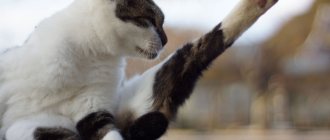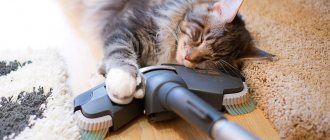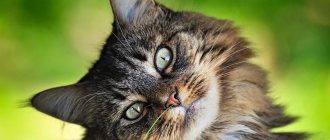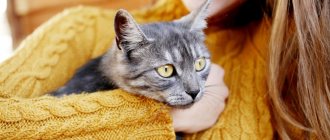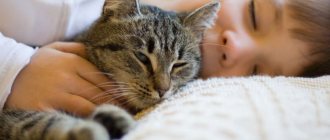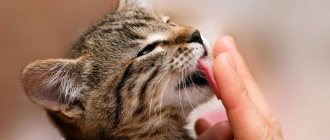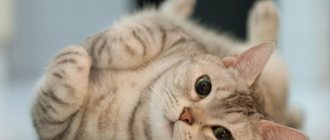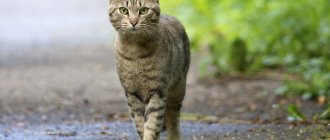The purring of a cat is one of the most pleasant sounds for an animal owner. But the mechanism of origin and its properties still remain a mystery. Even felinologists cannot say exactly when cats learned to purr. It seems that the hoarse vibrating sound relates exclusively to the expression of emotions, but this is not so.
Let's find out what a cat purrs about and how to react to this behavior of a pet.
Specifics of sounds made by cats
A cat purrs when it feels pleasure and more
Many owners of furry pets have probably wondered why cats purr. In order to communicate with people or other animals, cats use various types of communication. Rumbling is one of them. A pet can show its mood through various gestures, the position and vibration of its tail, and also by making sounds.
First, let's look at what is meant by rumbling.
The rumbling and purring that the mustachioed-striped one makes is accompanied by rhythmic vibration in parts of the animal’s body. This is one of the ways of communication, healing and reassurance, reporting the animal's condition.
Interesting: Only felines can purr.
How purring occurs
The sound originates between the base of the skull and the base of the tongue. In the cat's brain, impulses arise that provoke contraction of the muscles near the vocal cords. The bones under the tongue create a vibration that spreads throughout the animal's body.
Their ability to purr depends on the structure of the hyoid bone of baleen animals. Domestic cats have a triangular-shaped bone, thanks to which they are able to purr continuously both when exhaling and inhaling. Large felines have a rectangular bone under the tongue. This allows them to make roaring sounds to intimidate and scare away enemies, but they can only rumble when exhaling.
Video with a visual demonstration of the anatomical causes of purring:
Many other animals make sounds similar to purring, such as guinea pigs, rabbits, raccoons and hyenas. But this cannot be called purring to the fullest extent. Only cats can truly do this.
Reference! While purring, it is impossible to listen to the animal's heart and lungs.
Cat purring mechanism
The sound of rumbling comes from the cat's larynx
Since humans cannot make purring sounds, like all other animals, the question arises, what do cats purr with? Do they have any special rumbling device for this? It turns out that not everything is so complicated.
The pleasant, soothing, soft sounds of purring occur as a result of the contraction of the throat muscles and the vibration of air inside the larynx, which leads to vibration. The amplitude, tone, and duration of purring may vary in cats, but the vibration frequency is within 20-30 Hz. The rumbling does not stop with inhalation and exhalation, but on the contrary occurs just during breathing.
When a cat purrs, a certain hormone is produced that has a calming function.
Research has also shown that the vibration from the purr strengthens the animal's bones, joints and skeleton due to the vibrations of the air. This is explained by the fact that such a habit could have been developed in the animal due to a sedentary lifestyle and to prevent muscle atrophy.
Interesting: kittens begin to purr when they are a couple of days old.
Why do cats purr and how do they do it?
Man did not domesticate the cat. Since ancient times, these cute, furry creatures lived with people side by side under the same roof. Cats brought comfort into the house and protected homes from mice and other small rodents. But for many centuries, cats have raised many questions for humans, the answers to which are difficult to obtain. One of the most interesting is: why do cats purr and how do they do it? For many decades now in various countries, scientists have been trying to answer this question. And here are the conclusions they came to:
The main reasons for a cat's purring
A cat purrs when he feels safe, but may also purr to relieve stress or pain.
A cat's purring is never without a reason. Purring expresses their emotional and physical state.
It is generally accepted that cats purr only when they are happy. Surely in most cases it is for this reason.
However, a cat's purring can also be detected when the cat is excited, scared, injured, before giving birth and at other exciting times. Why does she purr when he is stressed? In this way, the animal calms and heals itself.
To better understand the reason for purring, let’s look at the accompanying actions of the animal.
- It stomps its paws on or near a person and purrs. The animal marks its owner in this way, demonstrating its own importance.
- Rumbling when stroking indicates that the cat is receiving true pleasure.
- A loud, restless purr, similar to a tractor, accompanied by accompanying soft and cute movements, may indicate an injury to the animal. It is necessary to pay attention to whether she is experiencing a painful condition, whether she is trying to crawl out of the wound, whether she is experiencing discomfort and other disturbances in her general condition.
- The purr of a mother cat while feeding her cubs calms the babies.
- A cat may also purr after a tasty and satisfying meal and during a nap.
- A cat's purring can also be its anticipation of pleasant moments: treats, emotions, games.
- A caring pet may begin to purr, sensing the painful state of its owner, in an attempt to calm him down.
- A cat purring during a meeting with a veterinarian may indicate that the animal is stressed and trying to calm down.
Cats purr when communicating with their own kind.
In addition, cats also use purring when communicating with their own kind. If a cat purrs when meeting another animal again, this indicates that she is in a friendly mood. The purring of a cat during aggressive play or a fight with another cat is evidence that she is giving up and raising the “white flag”.
Rumbling can also express boredom, or a cat may begin to purr before a serious and responsible action, such as jumping from a high cabinet.
Scientists have not yet figured out the exact reasons for the start of the rumbling mechanism in mustaches.
Interesting: Cats can’t purr in their sleep, but they can easily purr during a nap.
Mechanism of purring (vocal cords, diaphragm, vascular theory)
One of the options for the formation of unusual sounds that representatives of the cat family make relates to the work of the respiratory organs, muscles in the larynx and vocal cords.
Studies using an electromyograph (a device for studying bioelectrical muscle potentials) have shown the mechanism of a cat's purring to be the use of vocal folds or laryngeal muscles. By rapidly alternating expansion and contraction of the sound passage, they cause rhythmic continuous vibrations of air in the inhalation-exhalation cycle.
It is in this cycle that the characteristic rumbling of a cat is born. The hypothesis does not illustrate all the features of the occurrence of noise, and therefore remains one of the puzzles in a puzzle that has not yet been solved.
Another failed discovery is the launch of the mechanism through the lungs and diaphragm. Observers came to this conclusion when they compared the cat’s purring and its breathing pattern. But they were never able to explain the entire line of behavior, from managing desire to its implementation.
Blood pressure was also not forgotten. They checked how it circulates through the vessels and even suggested the presence of hemodynamic processes - purring is formed as blood moves through the chest. No irrefutable evidence has been found, but at the level of rumors, this hypothesis is being discussed among cat lovers.
The next point of serious research is the hyoid bones and the degree of their hardening. It was noticed that animals cannot both purr and growl at the same time. Therefore, purring cats were enrolled in one group, and roaring cats in the other.
A characteristic feature of the first (including domestic ones) is a completely ossified ligament of the hyoid bones, while in representatives of the second group this property is partially expressed. The exception is the snow leopard. He can purr, like a cat next to a person, but his hyoid bones are not hard.
The most reliable option explaining purring is neurophysiological. A neural network oscillator was discovered in a cat's brain. This phenomenon is complex and even in humans has not been fully studied. Its job is to cause brain waves, which cause the nervous tissue to generate oscillatory activity. These impulses seem to control the hyoid bones, and they, in turn, cause the vocal cords to vibrate.
This is interesting! Cats purr with both their nose and mouth at the same time. At the same time, the body resonates so much that it is impossible to listen to the work of the heart or lungs.
Why do cats purr near humans?
Cat expresses gratitude and bond with owner
Is the person the owner of the cat or the cat the owner? Everyone thinks differently. If a cat actively presses its paws on the owner's chest and purrs at the same time, this means that it shows him its superiority over him, marking him as his property.
But rumbling towards a person can express gratitude, affection, greeting, recognition, a request for attention or food, or the joy of playing with the owner.
Accompanying purring with active drooling next to a person or on a person speaks of sincere and genuine love and trust in him.
Feeling the sadness and illness of its owner, the cat can also get closer to him and begin to purr. Thus, she wants to restore the mood and condition of her owner, healing him from his illness.
Causes of purring in cats
Cats purr while eating and communicating with their owner and other cats. This is a traditional sign of pleasure. Most often, the pet behaves this way during affection or play. Small kittens use purring to tell their mother that they are full and happy . The mother cat calms and encourages the little ones with the same purring. Adult domestic cats purr when they want to play with each other. It's the sound of friendliness. Cats make purring sounds when they are sick. In this way they pacify the pain and calm themselves down.
Interesting fact: scientists have found that only lynxes and domestic cats make soft purring sounds. In large representatives of the cat family, the hyoid bones are covered with cartilage, which does not allow vibration to pass through. The lion growls, the other big cats hiss, but do not purr.
Why do cats purr when petted?
In fact, human touches are irritating for a cat, but she may not always react with displeasure. It is clear that if you stroke your pet against the grain or when he is not in a good mood, then in this case the cat may twist its tail in displeasure or even scratch it.
However, if you gently pet your pet when she wants it, she will most likely begin to purr with pleasure. Cats are very sensitive to the mood of the owner and see when he strokes lovingly, so they purr in response, expressing mutual love and trust.
Rumbling as a help to a person
Some pets that experience special love and affection for their provider may purr, as they say, for medicinal purposes. And judging by the reviews, it actually works. Loved and loving animals are great for relieving stress, helping you sleep, and even treating some illnesses.
The purring of a cat is useful for humans in a variety of situations, and today they are trying to use this ability in medicine. Purring can have beneficial effects in the following ways:
- cerebral circulation improves, resulting in increased brain activity and performance;
- blood pressure and heart rate return to normal;
- the immune system is strengthened, especially in relation to colds;
- stressful situations are experienced much easier and without any negative consequences for the nervous system and general well-being;
- sleep is normalized and its quality improves - it becomes strong and the time to fall asleep is reduced;
- If the cat constantly lies down on the sore area and purrs at the same time, then a faster cure for colitis, gastritis, osteochondrosis and peptic ulcers is possible.
A cat living in a house is capable of lifting the mood and acting on its owner in an exclusively positive way by purring. When a person strokes his pet and she begins to emit guttural vibrations, a bioenergetic contact occurs between them, in which the animal takes away all the negativity.
On a note! It has been established that quite a few animals purr while at rest, and scientists regard this as a unique way to once again strengthen the health of both their breadwinner and themselves!
Communication with kittens
A certain purring dialogue takes place between the baby and the mother. The kitten purrs and tells its mother that everything is fine with him, he is full and feels great. The mother, in turn, purrs to the baby that he is safe.
Such “conversations” are started for a reason. The predatory roots of cats force the animals to be always on the alert. You cannot make noise, otherwise if you hear meowing you will attract danger in the form of wild animals.
Purring, the cat calms down
In a stressful situation, Murka stabilizes its emotional state by purring. Thanks to the amplitudes of a certain frequency, the animal’s blood pressure normalizes, the heart rhythm improves, and the nervous system calms down. The pet seems to be fenced off from the external bustle and focuses on its sensations. Often in an unfamiliar situation, an excited cat begins to purr.
The rumbling serves as a kind of sedative before bed. When tuning in to rest, the cat “vibrates”, trying to calm down and distance itself from external hustle and bustle: noise, light and movement.
Menacing purr
When taking an attack pose, a cat may purr threateningly.
But besides peaceful and measured purring, cats have other types of rumbling, including one of the most common - threatening.
When a pet feels that it, its cubs, or its owner are in danger, it may begin to make aggressive purring sounds. At the same time, the animal assumes a posture for attack - paws spread, arched back, slightly tilted head. Also, in some cases, purring can be a sign of anxiety in a cat.
The cat is sick
In severe pain, cats rumble dully and deep in low frequencies.
Pets can make purring sounds not only during periods of aggression or calmness, but also when they feel unwell. For example, when there is severe pain, cats rumble dully and deep at low frequencies. Usually this is not at all similar to the usual peaceful purring of a pet, and an attentive owner can immediately notice that his pet is sick.
Charging the muscles
Experts are inclined to say that the process of purring is akin to exercising the muscles. An animal that spends half its life sleeping maintains muscle tone with the help of mysterious vibrations.
How to determine a cat's desires by purring
Rubbing and purring? She clearly needs something from a person, most likely food or she’s just bored
The timbre, amplitude, and volume of purring reveal different emotions and desires of the animal.
- A loud and worried rumbling indicates pain (injury or illness). It is necessary to observe the animal, establish accompanying symptoms and help it.
- Increased rumbling and active tail wagging indicate the animal's dissatisfaction. If the owner strokes the cat at the same time, it means that these actions must be stopped, she does not like it.
- A nursing cat protects her offspring with a loud purr and signals that no one should approach her or her kittens.
- A soft purr and closed eyes indicate the pleasure the animal receives.
- The cat purrs and rubs against the owner - it requires attention or treats.
Important: a cat can purr before dying.
When does a cat purr?
Kittens are born blind and deaf, so they can only find their mother by the vibrations that occur during purring. This sound is automatically associated with the mother, with the pleasure of absorbing milk, with a feeling of safety and security. In such an environment, anyone will purr with pleasure.
All cats purr at the same frequency - 25 cycles per minute.
There is no need to explain to a kitten how to learn to purr - it is an innate skill. Sometimes this happens involuntarily, simply from an overabundance of positive emotions:
- when a person strokes a pet;
- when a cat eats a tasty treat;
- even when he sleeps and dreams about something pleasant.
Some pets purr for humans as a way to calm them down or thank them for something. For example, if the owner is very nervous at the veterinarian, but the animal is not afraid, it may begin to purr and rub its muzzle against the person. So he tells you that everything is fine and you shouldn’t worry so much.
Or maybe they thank you for such participation.
The effect of a cat's purring on humans
Rubbing and purring? She clearly needs something from a person, most likely food or she’s just bored
Purring not only brings pleasure and relaxation to the cat itself, but also has a beneficial effect on the human condition.
Stroking the animal and feeling the vibrations from the rumbling with your hand helps a person cope with stress, anxiety, relaxes him, and reduces the risk of heart disease.
The sounds and vibrations produced, according to experts, have a positive effect on human health in the following areas:
- For muscle, joint and bone pain.
- With decreased immunity.
- Psychoneurological disorders.
- Diseases of the heart and digestive organs.
- For blood pressure.
- Helps with headaches.
- For respiratory problems.
Purring is not the only source of recovery, but it helps to alleviate the general condition, improve mood and relieve anxiety.
The most purring breeds
Maine Coons are affectionate and loving pets
The breed of the cat does not matter for the animal's purring, nor does age or gender. However, the rumbling depends on the character and disposition of the pet. More affectionate cats purr more often, and touchy-feely cats purr less often.
Some of the most affectionate and purring felines are:
- The Russian Blue cat, which has an open and gentle character, loves to play with children.
- The Sphynx is one of the most responsive breeds, allowing itself to be stroked, sat on your lap and played.
- Siberian and Neva masquerade cats are very affectionate to their owner and are not stingy with warmth, kindness and love. Always ready to help and cheer up with purrs.
- Maine Coons, despite their size and serious appearance, actively demonstrate their love for their owner and are not shy about it.
I also have a gentle disposition in such breeds as Burmese, Abyssinian, exotic and ragdoll cats.
But other cats, depending on their mood, are ready to bestow their relationship with their owner with warmth and a pleasant purr.
Why or why do cats purr?
Many owners of their furry pets can go on and on about how and when their cats start telling stories. Some people start purring as soon as you start stroking them, others, without any caresses, follow on their heels and purr. For some, they sneak into bed when the owner is getting ready to go to bed and, settling down next to him, begin a soothing monologue.
But there is another type of cat, one that almost never purrs. It can be very difficult to get these soothing sounds from them. You don’t need to look far for an example; I had a cat from whom I only heard purring a couple of times in his entire life. For me it was a real holiday, from the fact that my cat condescended to me with his attention.
Usually, when a cat comes up to rub against your legs, falls on its side or on its back, it shows that it is inclined to affection. As a rule, his actions are accompanied by rumbling.
How it happens
Cats do not have any special organ that is responsible for producing such sounds. In the course of research, scientists found that this occurs due to electrical impulses that arise in the cerebral cortex of a furry pet.
These impulses are sent to the muscles located near the vocal cords. As a result, the vocal cords begin to contract. The cat purrs with its mouth and nose, and the vibration can be felt on any part of the cat’s body.
Kittens use purring as a means of communicating with their mother. Moreover, they can purr already 48 hours after their birth. This can continue until they feed on the milk of their mother cat and reach 5 weeks of age. During this process, the mother of the kittens calms them down with mutual purring.
Purring is also accompanied by the procedure when a mother cat licks her cubs, caring for their fur and washing them. As kittens grow up, they will use similar sounds to communicate with other cats and, of course, with people.
With these mesmerizing sounds, cats express satisfaction. They anticipate the pleasure of the expected food. They rejoice when they meet their owners upon returning home. They experience pleasant sensations from their owner's hands stroking them.
At its core, purring is a way of showing people that you are dependent on them. As once before, they also purred to their mother, completely dependent on her. And of course, as a way to show the importance of the emotion experienced in this case.
By the way, cats that are sick, injured or injured can also purr. By and large, they do this on a subconscious level in order to calm themselves down.
Of the large cats, lynxes and cheetahs and some other representatives of small wild cats can purr. This is due to the special structure of the hyoid bone, which is very similar to the bone of domestic cats. Oddly enough, other animals can also purr:
- hyenas;
- Guinea pigs;
- mongooses;
- genets.
Mongoose can purr Hyena also has the ability to purr Guinea pig is a domestic animal that, in addition to cats, has the ability to purr Lynx, although it belongs to wild cats, can still purr Geneta is an animal that purrs no worse than a cat Despite all its power, the cheetah, like a domestic cat, purrs
We believe that cats make this velvety sound when they experience pleasant emotions... This is true, but only partly.
It turns out that an animal can purr for many reasons, and not only when it feels good. That's what we thought!
A way to calm down
In stressful situations, cats begin to purr. This happens due to the fact that in childhood, when the mother was nearby, she would certainly purr songs to the kittens and thereby calm the tailed baby. In this way, small, adult and old cats try to calm themselves down in difficult life situations.
Have you noticed that these sounds appear at the most inopportune moment? For example, during unloved combing or, in general, at that moment when the cat is angry and bites! It turns out he does this in order to pull himself together. The sounds produced have a calming effect on them.
Greetings
But our pets do not always purr when they are in a bad mood. When you come home and the cat greets you with a purr and a joyful “purr”, affectionately rubbing itself and walking with its tail, it means that it is glad to see you. Often, along with purring, cats like to hug and poke their noses in our faces. This is how they show us their love (by the way, sometimes animals can make half-meow, half-murmur noises). Well, isn't it nice?
Sound therapy
It turns out that the sound of purring is pleasant not only for humans! By using their vibration, kittens are able to recover faster and also help us in this. The low timbre of this sound improves metabolic processes, promotes the healing of wounds and abrasions, and reduces pain. It’s not for nothing that they say that a cat lies down on a sore spot to heal it! So take your furbaby and get some relaxing sound therapy!
Interesting facts about rumbling
Cheetahs can purr too
- Not only domestic cats have the purring function, but also such predators as the cheetah, snow leopard, raccoon, puma and jaguar.
- But the tiger and lion can growl more than purr.
- Large ones from the cat family purr when exhaling, which is more like a roar, and small ones both when inhaling and exhaling.
- A cat can purr only with one inhabitant of the house, whom it recognizes as the owner, and react to others with complete silence.
- To stop your cat from purring at the veterinarian's appointment to measure her heartbeat, you need to drown out her purring with the sound of water, and she will become silent.
- Cats purr from birth until death. Before her death, these may be the last sounds she makes. This is how she tries to calm down and ease her anxiety.
- Since kittens are born deaf and blind, the mother cat's purrs help them locate her and feel safe.
- There are services for listening to cat purrs online.
- Purring helps cats recover from injuries, promotes bone healing and strengthens joints.
- Purring before bed helps cats fall asleep.
- During long sleep, rumbling replaces physical exercise for the cat.
- In 2015, the cat Merlin was included in the Guinness Book of Records for the loudest purr of about 68 decibels (average frequency 25 decibels), that is, the noise level between a sewing machine and a hair dryer.
That loud cat Merlin and his owner
Yet, in most cases, with its purring, a cat next to its owner expresses its love, recognition, calmness and trust. A cat, with its purring, will not only thank its owner for his care and kindness, but will also help him cope with fatigue, stress and increase his immunity.
If the cat is happy, the owner is happy too.
Mr. Cat recommends: interesting facts
Purring is a process unique to the animal world. But among the purring ones there are their own records:
- The volume of the rumbling varies in the range from 16 to 100 dts.
- The English cat Merlin purrs four times louder than an ordinary pet. The sound is so loud that it drowns out a running hair dryer. Eyewitnesses compare the cat's purring to the sound of a landing plane.
- The kitten makes its first “murr” at the age of two days.
- The most “purring” country in the world is Australia, where there is a cat for every resident.
For example, cats purr especially intensely during childbirth. This helps them not only calm down, but also breathe correctly.

